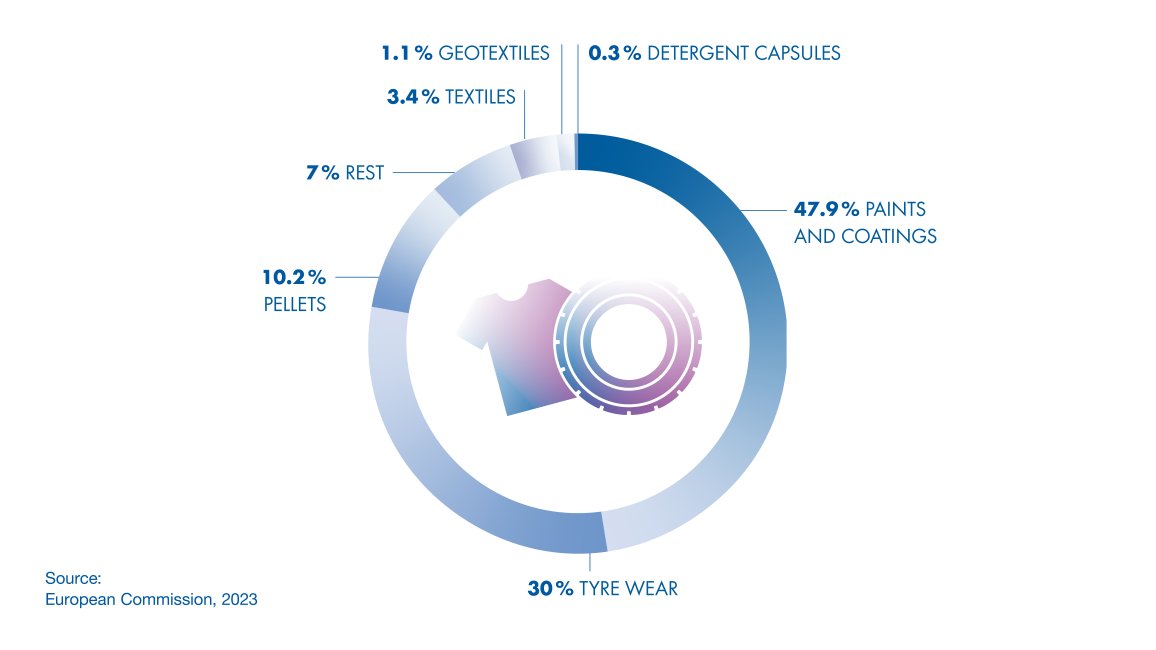Microplastics: Distribution, sources, and state of research
Microplastics are ubiquitous. These tiny plastic particles have been detected in oceans, soil, the air, and even in the human body. But what exactly are microplastics? Where do they originate – and what does science say about potential effects?

What Are Microplastics?
The term microplastics refers to plastic particles smaller than five millimeters. According to the European Chemicals Agency (ECHA), they are synthetic polymers that are organic, insoluble in water, and mechanically degradable. Even smaller are nanoplastic particles, which are under one micrometer (0,001 millimeters) in size and are considered especially mobile in biological systems.
In scientific discourse, two main categories are distinguished:
- Primary microplastics, which are intentionally manufactured in small sizes, for example for industrial applications or cosmetics.
- Secondary microplastics, which result from the breakdown of larger plastic items – caused by abrasion, UV exposure, or mechanical stress.
In addition to this classification, European legislation also differentiates between “intentionally added” and “non-intentionally released” microplastic particles.
Where Do Microplastics Originate?
Microplastics arise in various ways and come from diverse sources. An analysis by the European Commission shows that the largest amounts of unintentionally released microplastics in the EU come from the following sectors (estimated maximum annual values):
- Paints and coatings: approx. 863,000 tonnes/year: 25% of this relates to abrasion from ships
- Tire wear: approx. 540,000 tonnes/year: 55% of which concerns cars
- Plastic pellets: approx. 184,000 tonnes/year
- Textiles and geotextiles: approx. 80,000 tonnes/year

Additional contributions can come from packaging, especially when it ends up in the environment and gradually disintegrates. In such cases, secondary microplastics are formed, which can be significantly reduced through proper collection and recycling.
Microplastics in Food and Drinking Water
Several studies have found microparticles in both food and drinking water – including fish, shellfish, salt, tap water, and bottled mineral water. Some studies have detected microplastics in both single-use and reusable PET bottles, as well as in glass bottles. In certain cases, higher particle counts were found in glass bottles. The number of particles varies significantly and depends on particle size and the type of sample.
Interestingly, research shows that not all detected microparticles are made of plastic. In some studies, only around ten percent of the particles were actually identified as plastic. As a result, statements about the intake of microplastics through food remain uncertain.
Relevance to Human Health: What Does the Research say?
Microplastic particles have already been detected in various human tissues and bodily fluids – including blood, lungs, placenta, and breast milk. What long-term health effects might result from this is currently the subject of intensive research.
Regarding intake levels, the often-cited claim that humans ingest a credit card’s worth of plastic (5g) every week has been disproved by recent studies. In fact, it is only 0.000004 g, and it would take around 20,000 years to take in the amount of a credit card.
Animal studies have provided initial insights, but their results cannot be directly applied to humans. Therefore, statements about risks or quantities should be interpreted with caution.
The German Federal Institute for Risk Assessment, a scientifically independent government agency responsible for assessing the health risks of substances, published the following information again in July 2025: “Based on current knowledge, there is no reliable toxicological evidence of health risks from the ingestion of microplastics via food.”
The FDA (Food and Drug Administration) in the US and the German Food Association also point out that, according to current scientific findings, there is no evidence that microplastics or nanoplastics in food pose a risk to human health. However, other types of dust, such as paper, aluminum, and wood dust, have already received negative toxicological assessments.
Research Status and Outlook
Scientific engagement with microplastics is still in its early stages. There are no internationally standardized definitions, measurement methods, or risk assessments. This lack of standardization makes it difficult to compare studies and sometimes leads to contradictory conclusions. Yet fact-based debate and reliable data are crucial to developing sound long-term solutions.
Do you like our texts? Perhaps even so much that you want to use them in your own media? Then please get in touch with us beforehand!
